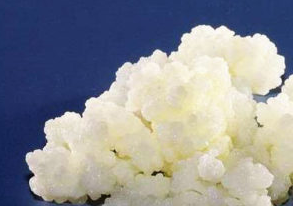The Kefir is a fungus well known for some, little for others. The resulting food is very similar to yogurt, since it belongs to the dairy family. It has great properties such as the regulation of the bacterial flora of the intestine, which helps in the digestive process.

Kefir is made from active ferments. You can find it in supermarkets, food stores (physical or virtual)… but you can also prepare it at home. When you do it this way, it tastes completely different, somewhat stronger than usual.
The fermentation process that kefir follows is very similar to that of yogurt. Among the microorganisms present in this food are those of the genus Lactobacillus, Lactococcus cremoris and lactis, Leuconostoc mesenteroides and the famous L. Casei del Actimel. The difference with yogurt is that it is formed by lactic fermentation, while Kefir does it by lacto-alcoholic.
As already mentioned, its main characteristic is that it intervenes in the regeneration of the bacterial flora. For this reason, it favors digestion, recommended when you take aggressive foods (for example, spicy) that destroy the microorganisms of the digestive system. It is very similar to kombucha.
I have read on other websites that kefir “fights the appearance of E. coli”. This bacterium has a symbiotic relationship with humans. We have E. coli in our body performing vital functions for our survival. The strain inside us is not pathogenic.
Another of its main benefits are:
- Contributes to the synthesis of vitamin B.
- Some doctors recommend it as a natural remedy for anemia.
- Prevents constipation and causes a laxative effect.
- Some studies claim that it could lower cholesterol
- It is a healthy food to maintain average blood pressure levels.
Now you will learn how to prepare kefir at home.
How To Make Homemade Water Kefir, Recipe Ideas
Making kefir requires following a few simple but orderly steps. You can see the following recipe:
- First of all, have a glass container on hand, if possible, with a wide mouth.
- The first thing to add is the confined nodules of the kefir. You can do it with a gauze. Depending on the size of the glass bottle, you will add 2-3 tablespoons.
- The next ingredient is sugar. About 50 g approximately. Sugar is the raw material necessary for the fermentation of kefir. It is its source of carbon, which it will oxidize in catabolic reactions for energy. If you increase the temperature, the fermentation process will be faster, but you have to be careful, because if you overdo it, you will kill the microorganisms and there will be no production. At the end of fermentation, kefir cannot be sweet.
- To flavor and improve its flavor, you can add a couple of dried figs. It also neutralizes alcoholic fermentation.
- Lemon juice: 2 tablespoons approximately (it is added at the end of the whole).
- Mineral water. It cannot be from the tap as it would alter the process due to chlorine. 1 liter.
- Once you have the mixture, you have to homogenize it with a non-metal spoon. It can be made of plastic, or wood. When you have stirred well, cover the bottle and let it ferment for a day. Remember that at least a third of the bottle has to be empty (with air).
- When the time has passed, uncover, stir the homemade water kefir and let it rest for another 24 hours.
- For a finer kefir, strain the liquid. Add the lemon seeds. The remaining nodules can be used in the next fermentation.
How do I know if I have done it correctly? When making homemade kefir, the flavor should have sour and sweet undertones. The best way to find out is by checking that the kefir nodules have grown. This means that fermentation has taken place. If not, the process has probably not been carried out properly.
Important points in preparation
Each teacher has his own trick. We leave you some tips so you can enjoy making kefir and get a better production. The first thing is to get a nodule. You can ask a friend or buy it in herbalists.
- Lump kefir should be stored at room temperature, in the dark. You can do it in a closet.
- In milk kefir, remember to always have some milk so you can continue your metabolism.
- If you want it to come out more diluted, use skimmed milk; On the contrary, if you prefer it thick, use whole milk and let it rest for more than 24 hours.
- You can make it from water, milk, goat…
- What you should keep in the fridge is the final product, with the strained granules. For a maximum time of 3 days.
- You can give kefir to a friend. you need at least an amount the size of a juggling ball. Freezer storage is also possible.
- If it comes out thick, you can combine it with some sesame seeds for additional flavor.
Does it have side effects?
It doesn’t have to. Kefir is a safe product like any other dairy when properly prepared. The problem stems from poor conservation, where stomach upset, diarrhea or even vomiting may occur… But they are exceptional and specific cases.

